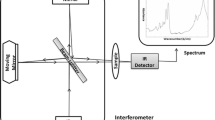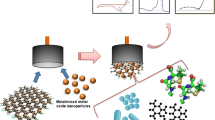Abstract
We report on a nanocomposite based genosensor for the detection of Neisseria gonorrhoeae, a bacterium causing the sexually transmitted disease gonorrhoea. Amino-labeled probe DNA was covalently immobilized on electrochemically prepared polyaniline and iron oxide (PANI-Fe3O4) nanocomposite film on an indium tin oxide (ITO) electrode. Scanning electron microscopy, transmission electron microscopy, electrochemical impedance spectroscopy (EIS) and differential pulse voltammetry (DPV) techniques have been employed to characterize surface of the modified electrode. The genosensor has detection limits of 1 × 10-15 M and 1 × 10-17 M, respectively, using the EIS and DPV techniques. This biosensor can discriminate a complementary sequence from a single-base mismatch and from non-complementary DNA, and has been utilized for detection of DNA extracted from N. gonorrhoeae culture, and from patient samples with N. gonorrhoeae. It is found to exhibit good specificity for N. gonorrhoeae species and shows no response towards non-gonorrhoeae type of Neisseria species (NgNs) and other gram-negative bacterias (GNBs). The affinity constant for hybridization calculated using the Langmuir adsorption isotherm model is found to be 3.39 × 108 M-1.

Electrochemically deposited nanostructured platform for Neisseria gonorrhoeae detection.






Similar content being viewed by others
References
Zhang L, Wan M, Wei Y (2005) Polyaniline/TiO2 microspheres prepared by a template free method. Synth Met 151:1–5
Zhang Z, Wan M (2002) Composite films of nanostructured polyaniline with poly(vinyl alcohol). Synth Met 128:83–89
Malinauskas A (2004) Self doped polyanilines. J Power Sources 126:214–220
Chandrasekhar P (1999) Conducting polymers, fundamentals and applications: a practical approach, 1st edn. Kluwer Academic Publishers, London
Olmedo L, Hourquebie P, Jousse F (1997) Handbook of Organic Conductive Molecules and Polymers (Ed.: H. S. Nalwa), John Wiley and Sons Ltd, Chichester.
MacDiarmid AG (2002) Synthetic metals: a novel role for organic polymers. Synth Met 125:11–22
Tran HD, Kaner RB (2006) A general synthetic route to nanofibers of polyaniline Derivatives. Chem Commun 3915-3917.
Skotheim JR, Elsenbaumer RL, Reynolds JR (1998) Handbook of conducting polymers. Marcel Dekker, New York
Diaz AF, Logan JA (1980) Electroactive polyaniline films. J Electroanal Chem 111:111–14
Singh R, Dhand C, Sumana G, Verma R, Sood S, Gupta RK, Malhotra BD (2010) Polyaniline/carbon nanotubes platform for sexually transmitted disease detection. J Mol Recognit 23:472–479
Dormann JL (1991) Fioranim D magnetic properties of fine particles. North-Holland, Amsterdam, pp 309–423
Ankamwar B, Lai TC, Huang JH, Liu RS, siao MH, Chen CH, Hwu YK (2010) Biocompatibility of Fe3O4 nanoparticles evaluated by in vitro cytotoxicity assays using normal, glia and breast cancer cells. Nanotechnology 21:075102 (9 pp).
Sun J, Zhou S, Hou P, Yang Y, Weng J, Li X, Li M (2007) Synthesis and characterization of biocompatible Fe3O4 nanoparticles. J Biomed Mater Res A 80A:333–34
Lu X, Yu Y, Chen L, Mao H, Zhang W, Wei Y (2004) Preparation and characterization of polyaniline microwires containing CdS nanoparticles. Chem Commun 1522-1523.
Lu X, Yu Y, Chen L, Mao H, Gao H, Wang J, Zhang W, Wei Y (2005) Aniline dimer-COOH assisted preparation of well-dispersed polyaniline-Fe3O4 nanoparticles. Nanotechnology 16:1660–1665
Ahmad R, Kumar R (2010) Conducting polyaniline/iron oxide composite: a novel adsorbent for the removal of amido black 10B. J Chem Eng Data 55:3489
Watterson J, Piunno PAE, Krull UJ (2002) Practical physical aspects of interfacial nucleic acid oligomer hybridization for biosensor design. Anal Chim Acta 469:115–127
Yang M, McGovem ME, Thompson M (1997) Genosensor technology and the detection of interfacial nucleic acid chemistry. Anal Chim Acta 346:259–275
Arotiba OA, Ignaszak A, Malgas R, Al-Ahmad A, Baker PGL, Mapolie SF, Iwuoha I (2007) An electrochemical DNA biosensor developed on novel multinuclear nickel (II) salicylaldimine metallodendrimer platform. Electrochim Acta 53:1689–1696
de-los Santos-Alvarez P, Lobo-Castanon MJ, Miranda-Ordieres AJ, Tunon-Blanco P (2004) Current strategies for electrochemical detection of DNA with solid electrodes. Anal Bioanal Chem 378:104–118
Sun X, He P, Liu S, Ye L, Fang Y (1998) Immobilization of single-stranded deoxyribonucleic acid on gold electrode with self-assembled aminoethanethiol monolayer for DNA electrochemical sensor applications. Talanta 47:487–495
Ge C, Miao W, Ji M, Gu N (2005) Glutaraldehyde-modified electrode for nonlabeling voltammetric detection of p16 INK4A gene. Anal Bioanal Chem 383:651–659
Drummond TG, Hill MG, Barton JK (2003) Electrochemical DNA sensors. Nat Biotechnol 21:1192–1199
Christopoulos TK (1999) Nucleic acid analysis. Anal Chem 71:425R–438R
Farabullini F, Lucarelli F, Palchetti I, Marrazza G, Mascini M (2007) Disposable electrochemical genosensor for simultaneous analysis of different bacterial food contaminants. Biosens Bioelectron 22:1544–1549
Bagni G, Osella D, Sturchio E, Mascini M (2006) Deoxyribonucleic acid (DNA) biosensors for environmental risk assessment and drug studies. Anal Chim Acta 573:81–89
Odenthal KJ, Gooding JJ (2007) An introduction to electrochemical DNA biosensors. Analyst 132:603–610
Kafka J, Pänke O, Abendroth B, Lisdat F (2008) A label-free DNA sensor based on impedance spectroscopy. Electrochim Acta 53:7467–7474
Keighley SD, Li P, Estrela P, Migliorato P (2008) Optimization of DNA immobilization on gold electrodes for label-free detection by electrochemical impedance spectroscopy. Biosens Bioelectron 23:1291–1297
Suni II (2008) Impedance methods for electrochemical sensors using nanomaterials. Trends Anal Chem 27:604–611
Ricci F, Plaxco KW (2008) E-DNA sensors for convenient, label-free electrochemical detection of hybridization. Microchimica Acta 163:149–155
Rodríguez LS, Pomales GS, Cabrera CR (2010) Single-walled carbon nanotubes modified gold electrodes as an impedimetric DNA sensor. Electroanalysis 22:399–405
Zhou N, Yang T, Jiang C, Du M, Jiao K (2009) Highly sensitive electrochemical impedance spectroscopic detection of DNA hybridization based on Au(nano)-CNT/PAN(nano) films. Talanta 77:1021–1026
Solanki PR, Arya SK, Nishimura Y, Iwamoto M, Malhotra BD (2007) Cholesterol biosensor based on aminoundecanethiol self-assembled monolayer using surface plasmon resonance technique. Langmuir 23:7398–7403
Chen SA, Lee HT (1995) Structure and properties of poly(acrylic acid)-doped polyaniline. Macromolecules 28:2858–2866
Cornell RM, Schwertmann U (1996) The iron oxide. VCH, New York
Kryszewski M, Jeszka JK (1998) Nanostructured conducting polymer composites - superparamagnetic particles in conducting polymers. Synth Met 94:99–104
Neault JF, Naoui M, Manfait M, Tajmir-Riahi HA (1996) Aspirin-DNA interaction studied by FTIR and laser Raman difference spectroscopy. FEBSLett 382:26–30
Kanakis CD, Tarantilis PA, Polissiou MG (2006) Interaction of antioxidant flavonoids with tRNA: intercalation or external binding and comparison with flavonoid-DNA adducts. DNA Cell Biol 25:116–123
Prabhakar N, Arora K, Singh SP, Pandey MK, Singh H, Malhotra BD (2007) Polypyrrole-polyvinyl sulphonate film based disposable nucleic acid biosensor. Analytica Chimica Acta 589:6–13
Caliskan A, Erdem A, Karadeniz H (2009) Direct DNA hybridization on the single-walled carbon nanotubes modified sensors detected by voltammetry and electrochemical impedance spectroscopy. Electroanalysis 21:2116–2124
Gu H, Su XD, Loh KP (2005) Electrochemical impedance sensing of DNA hybridization on conducting polymer film-modified diamond. J Phys Chem B 109:13611–13618
Fu Z, Yuan R, Xu L, Chai Y, Liu Y, Tang D, Zhang Y (2005) Electrochemical impedance behavior of DNA biosensor based on colloidal Ag and bilayer two-dimensional sol-gel as matrices. J Biochem Biophys Methods 62:163–174
Singh R, Prasad R, Sumana G, Arora K, Sood S, Gupta RK, Malhotra BD (2009) STD sensor based on nucleic acid functionalized nanostructured polyaniline. Biosens Bioelectron 24:2232–2238
Katz E, Willner I (2003) Probing biomolecular interactions at conductive and semiconductive surfaces by impedance spectroscopy: routes to impedimetric immunosensors, DNA-sensors, and enzyme biosensors. Electroanalysis 15:913–947
Szymańska I, Radecka H, Radecki J, Kaliszan R (2007) Electrochemical impedance spectroscopy for study of amyloid beta-peptide interactions with (–) nicotine ditartrate and (–) cotinine. Biosens Bioelectron 22:1955–1960
Matharu Z, Bandodkar AJ, Gupta V, Malhotra BD (2012) Fundamentals and application of ordered molecular assemblies to affinity biosensing. Chem Soc Rev 41:1363–1402
Acknowledgements
The authors thank Director, National Physical Laboratory, New Delhi, India for the facilities. Renu Singh and Zimple Matharu are thankful to Council of Scientific and Industrial Research (CSIR), India for the award of Senior Research Fellowships. The authors thank Mr. K. N. Sood and Mr. Jai Tawale, NPL for SEM measurements. We thank Dr. G. Sumana, Mrs. Rachna verma, Dr. V. K. Sharma, Professor and Head, Dermatology, AIIMS, Dr. J.C. Samantaray, Professor and Head and Dr. Arti Kapil, Professor, Microbiology, AIIMS, Dr. Manju Bala, Senior Microbiologist, Safdarjang hospital, New Delhi for useful discussions. We acknowledge the financial support received from DST [DST/TSG/ME/2008/18 and GAP-070932], in-house project (OLP-070632D) and Department of Biotechnology, Govt. of India (DBT/GAP070832).
Author information
Authors and Affiliations
Corresponding author
Electronic supplementary material
Below is the link to the electronic supplementary material.
ESM. 1
Supplementary data (DOC 110 kb)
Rights and permissions
About this article
Cite this article
Singh, R., Matharu, Z., Srivastava, A.K. et al. Nanostructured platform for the detection of Neisseria gonorrhoeae using electrochemical impedance spectroscopy and differential pulse voltammetry. Microchim Acta 177, 201–210 (2012). https://doi.org/10.1007/s00604-012-0765-x
Received:
Accepted:
Published:
Issue Date:
DOI: https://doi.org/10.1007/s00604-012-0765-x




